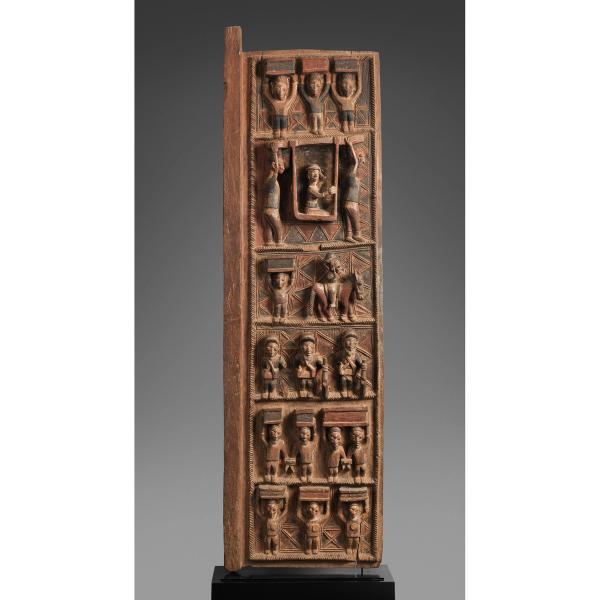Ìlẹ̀kùn ààfin (Ìsẹ̀ palace door)
Artwork Details
- Title: Ìlẹ̀kùn ààfin (Ìsẹ̀ palace door)
- Artist: Olowe of Ise (Nigerian, born Efon-Alaaye, ca. 1873–1938)
- Date: ca. 1904–1910
- Geography: Nigeria, Ise
- Culture: Yoruba
- Medium: Iroko wood, paint
- Dimensions: H. 85 3/4 × W. 25 5/8 × D. 4 1/2 in. (217.8 × 65.1 × 10 cm)
- Classification: Wood-Architectural
- Credit Line: Promised Gift of Carol and Jerome Kenney, in celebration of the Museum’s 150th Anniversary
- Object Number: L.2025.4.1
- Curatorial Department: The Michael C. Rockefeller Wing
Audio

1554. Ìlẹ̀kùn ààfin (Ìsẹ̀ palace door), Ọlọ́wẹ̀ of Ìsẹ̀
Roslyn Walker
ROSLYN WALKER: You notice the illusion of movement. The figures are looking forward, sometimes looking at you, and their bodies are turned differently, and their legs are one foot in front of the other. The figures are carved in high relief. The background is textured. Ọlọ́wẹ̀ liked to have patterned surfaces.
ANGELIQUE KIDJO: This is one of a pair of doors commissioned from master sculptor Ọlọ́wẹ̀ of Ìsẹ̀ to commemorate an important event at the palace in Ìsẹ̀ at the beginning of the 20th century—the visit of two British colonial officials, Captain W. G. Ambrose and Major W. R. Reeve-Tucker.
ROSLYN WALKER: I’m Roslyn Adele Walker. I am the curator emeritus of African art at the Dallas Museum of Art.
The door has six registers. The second one shows a man being carried in a litter. And that is Captain Ambrose, the traveling commissioner. Above him are porters carrying tax money or ammunition on their heads, and the register below Ambrose is Reeve-Tucker on horseback. The next register shows soldiers with guns, and then the last two registers show porters carrying boxes on their heads.
ANGELIQUE KIDJO: Ọlọ́wẹ̀'s distinctive style drew commissions from royalty and wealthy households for miles around.
ROSLYN WALKER: These artists are not anonymous. They’re known to the people in their communities; they’re known to their patrons. Ọlọ́wẹ̀ was recognized as a very extraordinary artist in his own time. The door is an extraordinary sculpture. Ọlọ́wẹ̀’s carving style was so unlike anything anybody else was doing in the Ekiti region or anywhere in Africa, for that matter. He honored the Yoruba canon but he made it his own. And I like to think he was a courageous man to do that.
###
Music: "Seven Lifes" by Beautiful Nubia and the Roots Renaissance Band, courtesy of EniObanke Gangan.